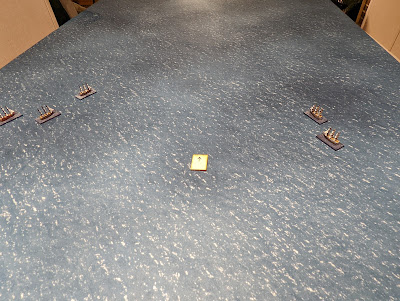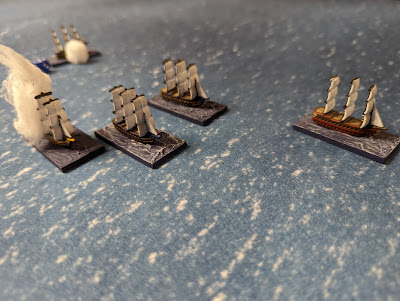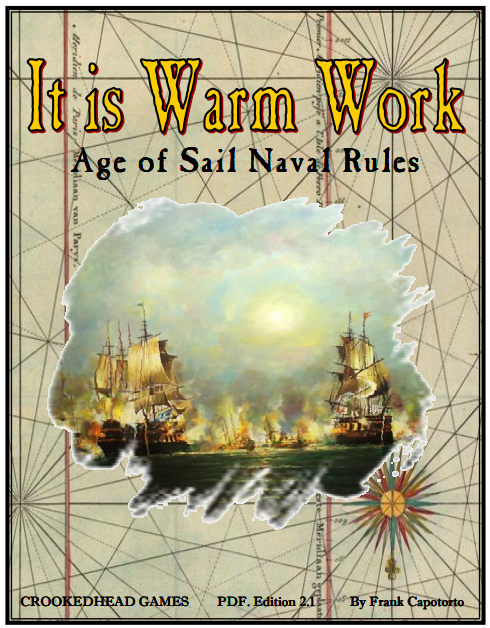Last night I tried out the Age of Sail rules "It Is Warm Work" which I purchased from Wargame Vault for the tidy sum of $5.95 I'd been on the lookout for a good set of Age of Sail rules for awhile now that hit a "sweet spot" in terms of their ability to play a large battle in a reasonable amount of time, and still deliver on that "Aubrey -Maturin" series or "Hornblower" saga feel that you get from the novels or screen.
My objectives? The rules would need to be simple enough for a land-lubber like me to
"learn the ropes", and yet still be satisfying and engaging, and play well solo. So no counting bilge rats in the lower galley, or rolling to see how long it takes Sailor's Mate Corcoran to fix a sail, I want the experience to meet my expectations for a naval game from the Age of Sail, be authentic, engaging, and suitable for fleet actions. I think I've finally found my white whale!
Our action today takes us to the Caribbean, somewhere off Hispaniola in 1805. The French are escorting a Spanish ship holding an "item of the utmost importance" back to Europe, and must slip past numerous Royal Navy patrols. The Royal Navy have strict orders to intercept and destroy the Coronado. Let's get to the action!
 |
| Sails Ahoy! The British lookouts spy 3 masts closing fast! |
 |
| R to L: French Frigate Duquesne, Spanish Ship Coronado, and French Frigate Carillon - all French ships are 38-gunners, and the merchant ship Coronado is armed. |
The objective of the French is to cross the table and exit off the far corner. They must protect the Coronado at all hazards! This mission has the attention of the Emperor himself, so whatever is on that Spanish ship, it must be important! By the way, ships are RISK pieces and at $30 for 60 ships, an outstanding deal.
 |
| The Frigates HMS Ulysses and HMS Serapis, 40 gun frigates, attempt to close with the French and destroy them! |
The first few turns are spent moving. Given their mutual positions on the table, all ships are able to move their maximum distance relative to the wind. IIWW has a handy gauge you can cut out that is placed over the ship model which tells you the movement distance allowed based on the ships position. Our ships in this game are headed towards each other quickly!
Another aspect I like is that you roll for initiative at the beginning of both the movement phase, and the fire phase. So it's not a given who will move first or fire first. I like this aspect and it made for some tense rolls throughout the game.
 |
| Turn 3 all ships are still moving quickly. Note my cool "wind" marker :) I forgot I had a marker set for the Osprey "Age of Sail" game which would have worked great for this engagement. |
 |
| When your sailing positions are favorable, you can move up to your max distance, which for Frigates is 10". Note here the Duquesne pulls away from the group while the Carillon provides cover for the Coronado. |
The Royal Navy Frigates see what is up and maneuver to keep pace with the French who are racing to the northeast!
Once the 2 x sides begin to close into firing range (10" long range, 5" short range) they slow a bit in order to maximize their ability to get a shot in.
 |
| While you roll lower for movement initiative, you must roll higher for firing initiative. The French win the initiative and the French guns open up! |
 |
| Duquesne fires on HMS Ulysses and scores a hit! |
 |
| In the return fire, HMS Serapis hits Carillon but at long range, only "6s" count. British ships are allowed to re-roll a single miss, which I missed, until the second or third turn of shooting, so I didn't use that rule for this game. |
Maneuvering priority now is to get the best shots off on the enemy, and for the French to continue to move the
Coronado off the table.
 |
| Ships maneuver into close range - Ulysses and Serapis on the right, and Duquesne, Carillon, and Coronado on the left |
 |
| HMS Ulysses and Duquesne prepare to exchange broadsides! |
 |
| I used the cotton puffs to show who fired. |
After a turn of inconclusive shooting, the ships continue to maneuver to get a raking fire shot off one another - the French hoping to cripple a British ship in order to maximize their chances for the Coronado to escape.
 |
| This is going to be ugly! Duquesne prepares to rake Ulysses |
In "
It Is Warm Work", raking fire hits on a 4+, but I think you can only "rake" at close range. I might have messed that up.
 |
| Duquesne scores a hit against Ulysses on the right, and Carillon scores 2 sixes against Serapis! |
It Is Warm Work uses a system where it tracks hits which reduce your firepower score. 38 Gun Frigates have 3 boxes - a "2" "2" and "1" box. When all boxes are checked you roll to see what happens to your ship. The Royal Navy frigates are slightly upgraded (40 gun) and have 4 damage points "2" "2" "1" "1". Both the Ulysses and Serapis are in trouble with both of their "2" boxes ticked off!
 |
| A confused, swirling fight! |
 |
| The Ulysses turns to get a raking shot against Duquesne while the Serapis (far right) moves to fire a broadside into Duquesne. |
The French have definitely gotten the upper hand in the engagement and the British ships are in big trouble with a box left each, and firing only 1 die. Their movement is reduced to 1/2 movement regardless of position. The Coronado is making good progress towards the table edge as well. While the French ships are damaged, the Royal Navy ships are close to striking!
During the next turn, a broadside from Duquesne forces the Serapis to strike! You roll on the table and I roll a "4" "ship strikes its colors." In this instance, the French do not have time to board her. They sail right past the striken Serapis, ending the chance for the ship to be captured yet again.
 |
| A final broadside into Serapis |
With the removal of another ship from the fight, and licking their own wounds, the Ulysses attempts to get a raking shot off against Carillon to hopefully even the odds.
 |
| note the white puff in the background as Ulysses fires a raking shot against the Carillon! |
Interestingly, stricken ships drift 2" with the wind. The stricken Serapis drifts into Duquesne as it attempts to sail off! You roll for fouling and I rolled a "1" which means they're fouled! After reading the rules though, a ship which has struck its colors cannot foul with another ship. So Duquesne is able to sail around the Serapis and escape.
So while the French forced Serapis to strike, they ignored her and sailed on. The French won the engagement and the Coronado delivers its cargo back to Europe.
A great game! I really enjoyed this little scrap, which took a just over an hour and fifteen minutes to play since I was reading the rules while playing. I'll go over what I most enjoyed, what I did not enjoy, and what I missed.
What I Liked
As far as Age of Sail games go, it was very simple and extremely easy to learn and play. I love the way ship strength, damage, and firepower are related, and I love the streamlined mechanics of moving and shooting. (even though I didn't play one, boarding actions are probably some of the most elegant I've seen among the various rules, both simple and complex, out there. I really liked the variable initiative for movement and for shooting. This made for a much more tense and exciting game and a much more fluid situation.
My decisions were about maneuvering my ships to get the best possible shots off against the opponent. Almost every question I had was answered by the rules. Also the rules are not long and are for the most part very well-written. There are neat extra rules for shore batteries and fortresses, and a system to build your own scenarios.
What I Disliked
As with all simple rules, there were some things missing. IE with drift - do ships drift with the wind? or relative to the wind as if they were sailing? The rules say "downwind 2 inches" so I simply pushed Serapis 2" along the direction of the wind but I wasn't sure.
What I Missed
Ships receive a saving throw from hits on a "6". I completely missed this although after re reading it's obvious in the rules.
British may re roll a single miss. I "missed" this until about halfway through the game.
Raking Fire - you only get the raking fire bonus at close range (5" or less) and I think it was applied in 2 x instances at longer range once against the French and once against the British.
OverallThese rules score an impressive 4.5 out of 5 ships-biscuits with me. They are the rules I'll play, and will paint up more ships to put on a larger game for my gaming friends.
After having read through numerous Age of Sail rules including Kiss Me Hardy, Fire As She Bears, Wooden Ships & Iron Men, Osprey's Fighting Sail, and Form On the Admiral's Wake, and also having played a few games of "Oak and Iron" with Ken, I will say that these rules, which seem to share much in common with the Junior General "
Trafalgar" rules, are my favorite, and my new "go to" set of rules for naval battles set in the Age of Sail. They're perfect for beginners, kids, land lubbers, and most importantly - big convention games with lots of ships on the table!



























































